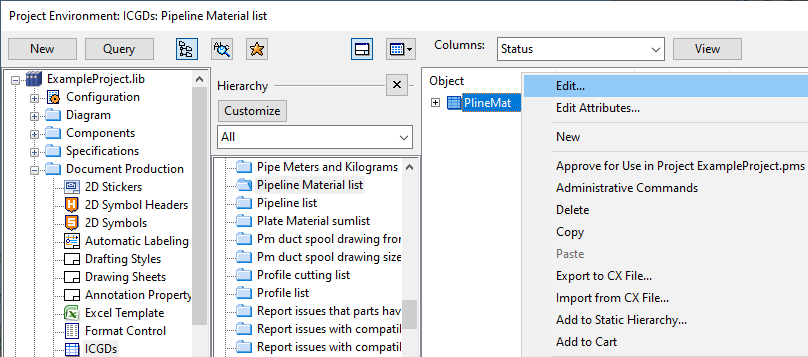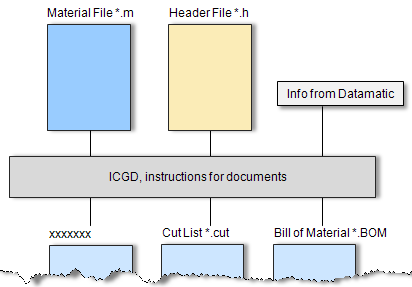ICGDs
In CADMATIC, "ICGD" stands for "Instructions Controlling Generation of Documents". As the name suggests, the ICGD contains sets of instructions that will be processed when a document that uses the given ICGD is being generated. The ICGD specifies what kind of data tables to process from the Material File (m-file) of the document, and whether the data tables should be plotted or printed. For example, it can control the data to be shown in the Bill of Materials (BOM) table. The ICGD may also define the default drawing sheet to use.

Normally the processing of a document takes place in three stages.
In the first stage, the application program requests Datamatic to process the m-file according to some ICGD. The resulting data tables are stored in ASCII files. Also, the user may be requested to provide header information.

In the second stage, the application program requests Datamatic to generate the final document. The data tables that are to be plotted are accessed as specified in the associated Drawing Sheets. For printable data tables, the ICGD specifies the contents and the name of each output element specified in the respective Format Control file.
In the third stage, the printable files are sent to the printers and the spooled plot files to a plotter. Each data table has its own set of instructions that define how the table is to be compiled.
The data tables and their processing can be characterized as follows:
-
A table can be plotted to the primary drawing sheet, to a separate drawing sheet, or it can be printed. The path name of a directory to contain the output file can be specified if the table is to be printed. Also the name of the format control file needed to format the output must be specified if the table is to be printed.
-
Title records can be defined for tables that are plotted.
-
Header fields can be defined for printable tables.
-
A set of selection rules define which entries of the m-file are included to the table.
-
Several keys can be used to sort the table into desired order.
-
It is possible to sum entries having the same key values; the system sums quantity fields such as "len" and "qty".
-
A table can be divided into paragraphs when the output records of the table are generated. A paragraph contains entries in which the primary sort key has the same value. Each paragraph is preceded by an output record containing one field: the title. For example, in an isometric drawing's Bill of Materials a paragraph could contain all the parts that belong to one spool.